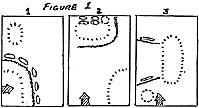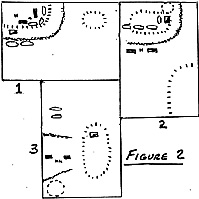My local club, luckily, is not averse to trying something a little different, so a few weeks ago we tried a "3 in 1" set in the Zulu war. The set-up for this sort of game is as follows. Ideally six players are needed, split into two teams of three and three conventional gaming boards are set up independent of each other. The boards all fit together at some point or other, but usually none of the players know how or even which is the center, left flank or right flank.
Each side is given the total forces at their disposal, divides them amongst themselves as they see fit. each picks a table on which to fight. For an hour or so, or until the umpire thinks an interesting or critical situation has been reached, the three games are fought as conventional head to head games. Then the games are halted, the boards are pushed together into their true positions to form one large battlefield and the game is continued as one large three-aside battle. If things have gone well, players should groan in disbelief, or smile with joy at the new situation they find themselves in.
We find that Zulu games can be a bit one-sided with British firepower usually telling over native bravery. In conventional games the Zulu advantages of speed and surprise based on local knowledge are overlooked, or clumsily included. The "3 in 1" set-up offers a few possibilities of redressing the balance, though we will have to "change the rules" of the game a little by allowing the Zulus to know: a) how the boards fit together and b) the rough direction of the British advance.
Tables Arranged
The scene now set, I arranged three 6 foot by 4 foot boards as shown in Figure 1, and gave the two teams the total forces at their disposal. The British, ignorant of the geography and Zulu plans, had to divide their forces into three parts, each capable of an independent attack and defence. The Zulus, with the advantage of local knowledge, were able to set up some kind of plan to "divide and conquer" by delaying and feinting on Tables 2 and 3, while concentrating the main attack force on Table 1.
I allowed a good hour for the "head to head" games to develop. On Table 2 the British pressed on from the beginning guessing the Zulus would be tucked away behind the gully or small hill. By the end of the solo hour, the lancers had gone to the right flank, flushed the Zulus out and persuaded them to go onto the attack. On Table 3 the British commander was panicked by the aggressive skirmishing and the presence of a herd of cattle on the hilltop, which he was convinced screened a Zulu advance. By the end of his solo hour, he had only just cleared the first gully, taking the added precaution of burning the scrub in and around it.
It was on Table 1 that the main action was taking place. The Zulus were lying low in and behind the gully, hoping to surprise the British when they came down from the hilltop. Wisely, the British commander had his cavalry scouting well to the front, and the rightmost Impi was located (on the British right) early on.
Foiled, the Zulus risked all on an all-out assault, uphill against the still deploying British. The left-most British unit was caught whilst still maneuvering and lucky to survive the first round of melee. The situation became more confused when a second Impi hit the now "L" shaped British formation, but this Impi was itself hit in the flank by the second British line unit. The hour was now up, and the tables put together (Figure 2).
Tables Rearranged
The British soon realized how isolated the forces on Table 1 were from the rest of the army. The British commander on Table 3 raced to assist the beleaguered forces on Table 1. On Table 2 a heroic charge by the Lancers was absorbed and the gatting gun over run, but the firepower of the infantry held back the bulk of the Zulu bands. But no matter what happened on these tables, it would be too late.
On Table 1 the British left crumbled in disarray. The fleeing infantry took the artillery crews with them so that half of the Imperial forces were now in flight. Total disaster was averted when the other British battalion broke the Impi to its front. They and the Frontier Light Horse raced through the gap, hoping to meet up with the British advancing from Table 3.
And there time called a halt to proceedings. There was little doubt that the British forces would eventually meet up, but there was also little doubt that the Zulus had the moral victory. Their battle plan had largely succeeded and one of the British columns had been severely mauled. From now on, the Imperial army would have to treat them with a little more respect.
The "3 in 1" scenario is adaptable to many periods - so why not give it a try. A little forethought is needed to ensure the players cannot work out too easily how the tables fit together. The tabletop terrain has to be positioned carefully so that it all meets up when the tables are united. It is interesting to throw a "red herring" or two as well. For example, the British thought the two large half-hills on Tables 1 and 2 matched up, but they could not have been literally further from the truth.
Back to MWAN #53 Table of Contents
© Copyright 1991 Hal Thinglum
This article appears in MagWeb (Magazine Web) on the Internet World Wide Web.
Other military history articles and gaming articles are available at http://www.magweb.com

